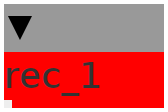rec
'arm' will arm the recorder, 'rec' will start recording to the selected slot or, when already recording,start another recording in a selected slot. you cannot record into a slot that already contains sample data. if already recording,recording will continue in the slot you were recording to before. when 'arm' is 0 again,recording will stop. sample start-and endpoints can be accessed 'from the outside' via the recorder-objects name.
Inlets
bool32.rising a pulse will start a recording a sample in the selected slot if 'arm' is 1 and the selected slot doesn't already contain a sample
frac32 additional data,for example timepoint of the recording start
frac32buffer audio in
int32.positive select a slot to record into (0 - 127)
int32.positive playback mode the currently recording slot will be set to
bool32.risingfalling arm the recorder
Outlets
bool32.pulse issues a pulse when a new slot is recorded
bool32 recording status
bool32 rec status && fade status
bool32 '1' if a slot already contains a sample
int32.positive slot currently recording to
frac32.positive remaining recording-time
Parameters
frac32.s.map.kdecaytime.exp attack
frac32.s.map.kdecaytime.exp release
Attributes
objref smplr
bool recstate;
bool fadetrig;
bool rtrig;
uint32_t fadepos;
uint32_t recstart;
uint32_t recend;
uint32_t rec_max;
int32_t env;
uint16_t slot_t;
uint8_t mslot;
bool full;
bool rectrig;rec_max = attr_smplr.W_LENGTH;outlet_recstart = 0;
mslot = (inlet_slot % 128);
full = attr_smplr.array[(mslot << 5) + 30];
if (inlet_arm) {
if (!full && (inlet_rec && !rectrig)) {
rectrig = 1;
if (attr_smplr.REC)
attr_smplr.array[slot_t + 29] = attr_smplr.REC_HEAD;
attr_smplr.RECSLOT = mslot;
slot_t = mslot << 5;
attr_smplr.REC = 1;
recstate = 1;
outlet_recstart = 1;
fadetrig = 0;
recstart = attr_smplr.REC_HEAD;
attr_smplr.array[slot_t + 28] = attr_smplr.REC_HEAD;
attr_smplr.array[slot_t + 30] = (inlet_playmode) ? inlet_playmode : 1;
attr_smplr.array[slot_t + 31] = __SSAT(inlet_Aux, 28);
}
}
if (!inlet_rec)
rectrig = 0;
if (!inlet_arm && attr_smplr.REC) {
attr_smplr.REC = 0;
attr_smplr.array[slot_t + 29] = attr_smplr.REC_HEAD;
}
// fades
if (attr_smplr.REC) {
env = (1 << 27) - (___SMMUL((1 << 27) - env, param_attack) << 1);
} else {
env = ___SMMUL(env, param_release) << 1;
if (!fadetrig) {
fadetrig = 1;
recend = attr_smplr.REC_HEAD;
fadepos = recstart;
}
}
recstate = env;
outlet_slotFull = full;
outlet_remain = (rec_max - attr_smplr.REC_HEAD) << attr_smplr.SHIFT;
outlet_recstate = attr_smplr.REC;
outlet_fadestate = recstate;
outlet_recslot = attr_smplr.RECSLOT;// record
int rv;
if (recstate) {
rv = __SSAT((___SMMUL(inlet_wave, env) << 5), 28) >> attr_smplr.W_GAIN;
if (attr_smplr.REC) {
attr_smplr.WAVE[attr_smplr.REC_HEAD] = rv;
if (attr_smplr.REC_HEAD < rec_max)
attr_smplr.REC_HEAD++;
else
attr_smplr.REC_HEAD = recstart;
} else {
rv += (attr_smplr.WAVE[fadepos]);
attr_smplr.WAVE[fadepos] = rv;
if (fadepos < recend)
fadepos++;
else
fadepos = recstart;
}
}